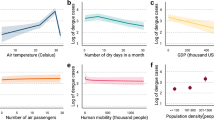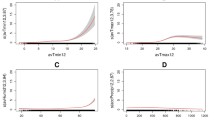Abstract
Dengue fever is the most important viral vector-borne disease with ~50 million cases per year globally. Previous estimates of the potential effect of global climate change on the distribution of vector-borne disease have not incorporated the effect of socioeconomic factors, which may have biased the results. We describe an empirical model of the current geographic distribution of dengue, based on the independent effects of climate and gross domestic product per capita (GDPpc, a proxy for socioeconomic development). We use the model, along with scenario-based projections of future climate, economic development, and population, to estimate populations at risk of dengue in the year 2050. We find that both climate and GDPpc influence the distribution of dengue. If the global climate changes as projected but GDPpc remained constant, the population at risk of dengue is estimated to increase by about 0.28 billion in 2050. However, if both climate and GDPpc change as projected, we estimate a decrease of 0.12 billion in the population at risk of dengue in 2050. Empirically, the geographic distribution of dengue is strongly dependent on both climatic and socioeconomic variables. Under a scenario of constant GDPpc, global climate change results in a modest but important increase in the global population at risk of dengue. Under scenarios of high GDPpc, this adverse effect of climate change is counteracted by the beneficial effect of socioeconomic development.


Similar content being viewed by others
References
Beebe NW, Cooper RD, Mottram P, and Sweeney AW (2009). Australia’s dengue risk driven by human adaptation to climate change. PLoS Negl Trop Dis 3:e429.
Bouwman AF, Kram T, and Klein Goldewijk K (2006) Integrated Modelling of Global Environmental Change. An Overview of IMAGE 2.4. 500110002, Bilthoven: Netherlands Environmental Assessment Agency
Bozdogan H (1987). Model Selection and Akaike Information Criterion (Aic) - the General-Theory and Its Analytical Extensions. Psychometrika 52:345-370.
Colón-González F, Lake I, and Bentham G (2011). Climate Variability and Dengue Fever in Warm and Humid Mexico. Am. J. Trop. Med. Hyg. 85:757–763.
Hales S, de Wet N, Maindonald J, and Woodward A (2002). Potential effect of population and climate changes on global distribution of dengue fever: an empirical model. Lancet 360:830-834.
Hales S, Weinstein P, Souares Y, and Woodward A (1999). El Nino and the dynamics of vectorborne disease transmission. Environ Health Perspect 107:99-102.
Hii YL, Rocklov J, Ng N, Tang CS, Pang FY, and Sauerborn R (2009). Climate variability and increase in intensity and magnitude of dengue incidence in Singapore. Global Health Action 2:1–9. doi:10.3402/gha.v2i0.2036
Huebener H, Cubasch U, Langematz U, Spangehl T, Niehorster F, Fast I, et al. (2007). Ensemble climate simulations using a fully coupled ocean-troposphere-stratosphere general circulation model. Philosophical Transactions of the Royal Society a-Mathematical Physical and Engineering Sciences 365:2089-2101.
IPCC (2007), IPCC Fourth Assessment Report, Bonn: Intergovernmental Panel on Climate Change
Jones KE, Patel NG, Levy MA, Storeygard A, Balk D, Gittleman JL, et al. (2008). Global trends in emerging infectious diseases. Nature 451:990-993.
Kovats RS, Campbell-Lendrum DH, McMichel AJ, Woodward A, and Cox JSH (2001). Early effects of climate change: do they include changes in vector-borne disease? Philosophical Transactions of the Royal Society of London. Series B: Biological Sciences 356:1057-1068.
Marti O, Braconnot P, Bellier J, Benshila R, Bony S, Brockmann P et al. (2006) The New IPSL Climate System Model: IPSL-CM4, Paris: IPSL
McMichael A (2003). Global climate change and health: an old story writ large. in A. McMichael, D. Campbell-Lendrum, C. Corvalan, K. Ebi, A. Githeko, J. Scheraga, and A. Woodward, editors. Climate Change and Human Health. Risks and responses. WHO, Geneva.
McMichael A (2004). Environmental and Social Influences on Emerging Infectious Diseases: Past, Present and Future. Transactions of the Royal Society 359:1049-1058
McMichael A, Campbell-Lendrum DH, Kovats RS, Edwards S, Wilkinson P (2002) Comparative Risk Assessment: Climate Change, Geneva: World Health Organization
McMichael A, Woodruff R, and Hales S (2006). Climate change and human health: present and future risks. Lancet 367:859 - 869.
McMichael AJ (2001). Human Frontiers, Environments and Disease: Past Patterns, Uncertain Futures. Cambridge University Press, Cambridge.
Mitchell TD, and Jones PD (2005). An improved method of constructing a database of monthly climate observations and associated high-resolution grids. International Journal of Climatology 25:693-712.
Nakicenovic N, and Swart R, editors. (2000). Special Report on Emissions Scenarios. Cambridge University Press, Cambridge, UK.
Otterå OH, Bentsen M, Bethke I, and Kvamstø NG (2009). Simulated pre-industrial climate in Bergen Climate Model (version 2): model description and large-scale circulation features. Geosci. Model Dev. 2:197-212.
Patz JA, Martens WJM, Focks DA, and Jetten TH (1998). Dengue fever epidemic potential as projected by general circulation models of global climate change. Environmental health perspectives 106:147-153.
Reiter P (2010). Yellow fever and dengue: a threat to Europe? Eurosurveillance 15:11-17.
Reiter P, Lathrop S, Bunning M, Biggerstaff B, Singer D, Tiwari T, et al. (2003). Texas lifestyle limits transmission of dengue virus. Emerging Infectious Diseases 9:86-89.
Rogers DJ, and Randolph SE (2000). The global spread of malaria in a future, warmer world. Science 289:1763-1766.
Russell R, Currie B, Lindsay M, Mackenzie J, Ritchie S, and Whelan P (2009). Dengue and climate change in Australia: predictions for the future should incorporate knowledge from the past. Medical Journal of Australia 5:265-268.
Van Kleef E, Bambrick H, Hales S (2010) Systematic review of the geographic distribution of dengue fever and the potential influence of global climate change. TropIKA.net, Geneve, 2010. Available from http://journal.tropika.net/scielo.php?script=sci_arttext&pid=S2078-86062010005000001&lng=en&nrm=iso. Accessed 31 Dec 2012.
WHO (2009) Dengue: Guidelines for Diagnosis, Treatment, Prevention and Control, Geneva: World Health Organization.
Woodward A, Hales S, Litidamu N, Phillips D, and Martin J (2000). Protecting human health in a changing world: the role of social and economic development. Bull World Health Organ 78:1148-1155.
Wu P, Lay J, Guo H, Lin C, Lung S, and Su H (2009). Higher temperature and urbanization affect the spatial patterns of dengue fever transmission in subtropical Taiwan. Sci Total Environ 407:2224-2233.
Author information
Authors and Affiliations
Corresponding author
Rights and permissions
About this article
Cite this article
Åström, C., Rocklöv, J., Hales, S. et al. Potential Distribution of Dengue Fever Under Scenarios of Climate Change and Economic Development. EcoHealth 9, 448–454 (2012). https://doi.org/10.1007/s10393-012-0808-0
Received:
Revised:
Accepted:
Published:
Issue Date:
DOI: https://doi.org/10.1007/s10393-012-0808-0




